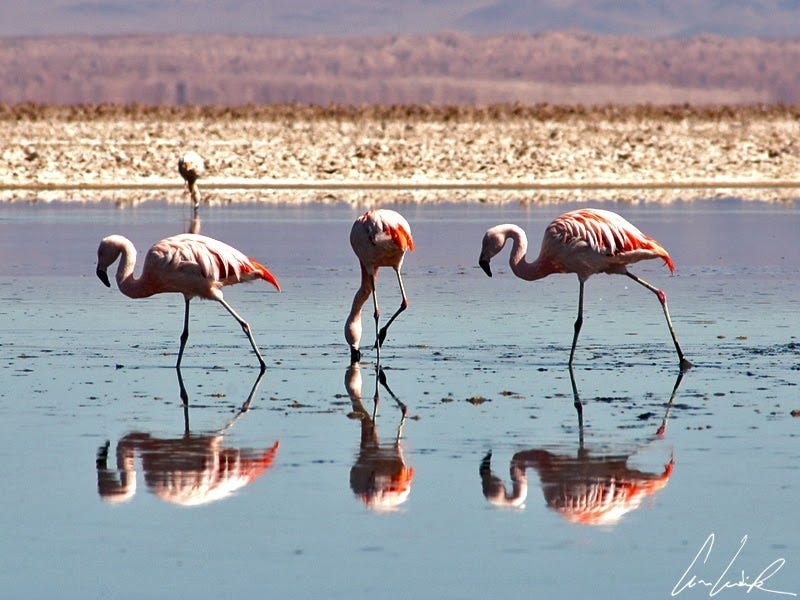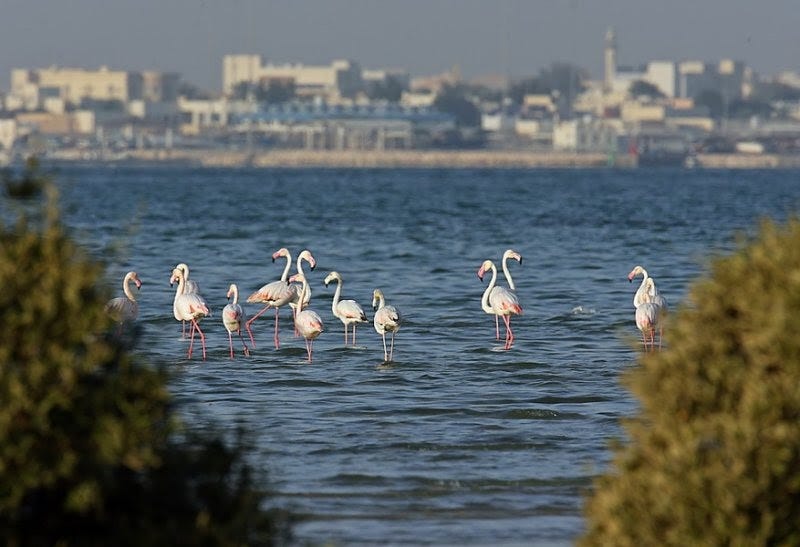Why is this interesting? - The Flamingo Edition
On migration, Qatar, and different species
Colin here. When we close our eyes and imagine a flamingo we see a beautiful, pink, otherworldly-looking animal. We might associate them with warm locales, luxurious amenities, or cartoon characters. In our mind’s eye, we envision them standing on one foot, lapping at the water. My understanding of the bird is more or less limited to the above. Turns out this picture is mostly just of a single species—the American Flamingo—and that the bird’s story extends far past the thin set of characteristics we associate with them.
In Chile, for instance, there are actually three species of flamingo: the Chilean flamingo, which is closely related to its American counterpart, as well as James’s flamingo, named after the naturalist Harry Berkeley James, and the Andean flamingo, which is the rarest of the bunch. Interestingly, all three species live in colonies with one another.
As travel and ecological blog ‘Tween Here and There explain:
The Andean flamingo is larger than James's flamingo with yellow legs and black tips on its wings, and takes on a very reddish-pink color when adult, especially the neck… It is the only flamingo with yellow legs and three-toed feet. Its cousin, the Chilean flamingo, is, at 50 inches, the tallest of the three and recognizable by its greyish legs with pink/red joints and with its half-black bill without any yellow. The Chilean flamingo is the only flamingo to perform a “dance” by spinning around itself and gently patting the area with its paws to force its favorite food, the artemia salina (aquatic crustaceans, a species of brine shrimp living in salt lakes), from the mud. The flamingo’s diet consists of microscopic elements present in the bottom layer of the lagoons, in particular diatoms (planktonic unicellular microalgae) and artemia salinas.
Why is this interesting?
Though our perceptions may lead us to believe that flamingos are content to hang out in exotic locales slurping up shrimp, snails, and algae, the animal in fact does quite a lot more traveling than their lawn ornament counterpart. Hundreds of Greater flamingos (the European cousin of the American variety) and other migratory birds have just been spotted at Al Thakira Mangroves in the North East of Qatar, using the country as a stopover the way human travelers might use Doha’s Hamad airport before continuing onwards.
The flamingos make the wetlands their home for up to six months as they migrate from Europe or Africa to Qatar in search of warmer climes. The country works with the charity, BirdLife International, which aims to protect the habitats of migratory birds. According to a blog post:
The Greater Flamingo (Phoenicopterus roseus) come to Qatar every November, mainly from African countries.These birds filter-feed on shellfish and algae - their oddly-shaped beaks are specially adapted to separate mud and silt from the food they consume, and are uniquely used upside-down. These birds usually leave Qatar by April when it starts getting too hot for them. From there, the birds go as far as North America.
While we might not be attuned to our same migratory patterns especially around the holidays, it is fun to see how the flamingos are still on the road, with a penchant for exotic and interesting locales. (CJN)
Mask of the Day:
Since COVID began, I’ve tried every type of mask possible. A lot of early ones hurt the ears or generally don’t feel good for extended periods. Uniqlo’s offering was the closest to good that I’ve found. But I’m ready to call it, the masks from Barriere are my favorite (and thanks to Outlier/Abe for the tip-off!). The company was founded by two female entrepreneurs, Cleo Davis-Urman and Alexa Adams, and makes premium FDA/CE certified medical grade disposable masks in fashion prints. They are comfortable, safe, and I dig the Tiger print on the safari pack. Shop everything here. (CJN)
Quick links:
Noma opens a burger joint (CJN)
Loving friend of WITI Chris Black’s pod, How Long Gone? (CJN)
Speaking of pods, SV4 on Claire and Erica’s “A Thing or Two” is a fun listen. Also, Claire and Erica need a morning TV show FOR REAL. (CJN)
Thanks for reading,
Noah (NRB) & Colin (CJN)
—
Why is this interesting? is a daily email from Noah Brier & Colin Nagy (and friends!) about interesting things. If you’ve enjoyed this edition, please consider forwarding it to a friend. If you’re reading it for the first time, consider subscribing (it’s free!).





The color of a flamingo comes from the food they eat...here in India I have seen a few sites with white/greyed flamingoes...another thing-they tend to 'like' pollution! See this- https://www.theguardian.com/cities/2019/mar/26/a-double-edged-sword-mumbai-pollution-perfect-for-flamingos